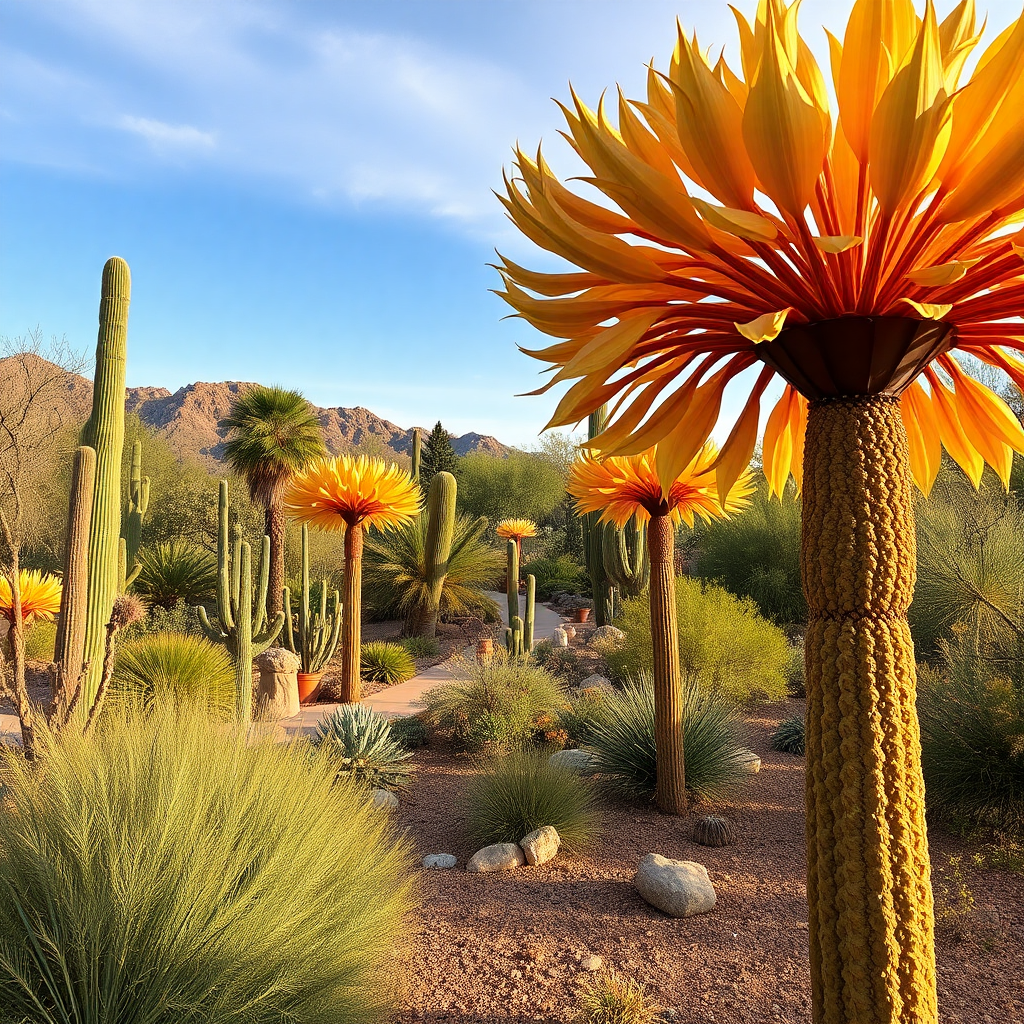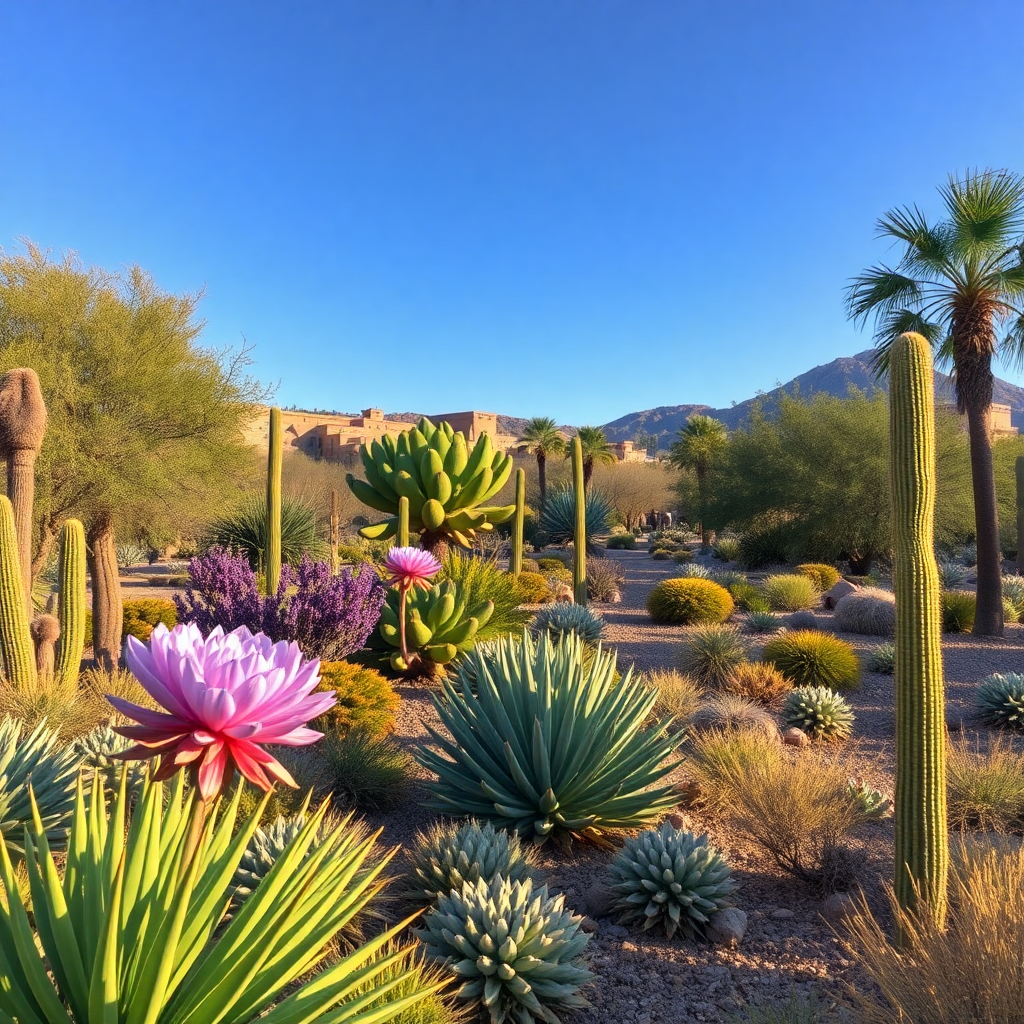Desert Botanical Garden:
Innovative Garden Design Ideas in Arizona

Did you know that desert gardens can use up to 75% less water than traditional landscapes while offering twice the biodiversity? The Desert Botanical Garden in Arizona stands as a testament to how garden design ideas can transform seemingly harsh environments into breathtaking, sustainable landscapes. This 140-acre conservation wonderland showcases ingenious desert landscape designs that challenge conventional gardening approaches. Whether you’re a homeowner seeking water-wise gardening landscaping solutions or simply an admirer of nature’s resilience, this botanical treasure offers a masterclass in designing with nature rather than against it.
Information About Desert Botanical Garden
The Desert Botanical Garden represents the pinnacle of arid landscape design excellence in North America. Located in Phoenix, Arizona, this remarkable garden features:
- 140 acres of meticulously curated desert landscapes
- Over 50,000 plant displays featuring 4,000 species from deserts worldwide
- 5 thematic walking trails demonstrating diverse garden design approaches
- The world’s finest collection of cacti and succulent plants
- Award-winning examples of water-efficient landscaping designs
- Desert-adapted plants from six continents
- Living demonstrations of traditional and contemporary desert gardening techniques
- Botanical research facilities advancing desert plant conservation
- Seasonal wildflower exhibits showcasing desert color possibilities
- Nighttime lighting designs that transform the garden after sunset
The garden serves as an unparalleled resource for anyone interested in sustainable landscape designs, drought-tolerant gardening practices, or connecting with the surprising beauty of desert environments.
Timing
A visit to the Desert Botanical Garden typically requires 2-3 hours to fully explore and appreciate its diverse collections. According to visitor data, most garden enthusiasts spend an average of 2.5 hours exploring the grounds—slightly longer than the national average of 2.1 hours for botanical garden visits. For those with specific garden design interests, early morning or late afternoon visits offer the best experience, as the angled sunlight dramatically highlights plant textures and forms while temperatures are more comfortable. The garden is open year-round, with peak blooming seasons in spring (March-April) and fall (October-November) offering spectacular wildflower and cactus flowering displays.
Step-by-Step Garden Exploration
Step 1: Begin at the Dorrance Center for Plant Conservation
Start your garden design inspiration journey at the entrance pavilion and orientation area. Pick up a detailed trail map highlighting specialized garden areas and seasonal highlights. Note how the entrance landscape immediately demonstrates how desert plants can create welcoming, lush-appearing spaces despite minimal water use. Pro tip: Take a photo of the plant identification signs near the entrance to reference these foundational species for your own garden design.
Step 2: Explore the Desert Discovery Loop Trail
Immerse yourself in the garden’s showcase trail where desert landscape designs from around the world demonstrate the incredible diversity of arid-adapted plants. Pay attention to how plants are grouped to create visual interest through contrasting textures, forms, and heights—a technique easily adaptable to home gardens. The specialized soil mixes and ground treatments show how proper foundation work supports thriving desert landscapes without excessive irrigation.
Step 3: Wander Through the Plants & People of the Sonoran Desert Loop
Experience how traditional Indigenous gardening techniques have influenced modern xeriscaping principles. This trail demonstrates how food-producing plants can be integrated into ornamental landscape designs—perfect inspiration for edible desert gardens. Notice the clever use of shade structures and plant placement that creates microclimate zones, extending growing possibilities even in challenging environments.
Step 4: Marvel at the Harriet K. Maxwell Desert Wildflower Loop Trail
Study how seasonal color can be incorporated into water-wise garden designs through strategic placement of desert wildflowers and flowering shrubs. This area brilliantly demonstrates how to create year-round visual interest with plants that require minimal supplemental water. The trail showcases companion planting techniques that support beneficial insects while creating stunning visual compositions.
Step 5: Find Shade in the Sybil B. Harrington Cactus & Succulent Galleries
Discover how architectural plants create drama and structure in garden design through this world-class collection. While your home might not accommodate massive saguaros, the design principles—using specimen plants as focal points surrounded by complementary ground covers—translate perfectly to residential xeriscapes. Note how container displays demonstrate options for small-space desert gardening with transportable garden elements.
Step 6: Explore the Berlin Agave Yucca Forest
Witness the dramatic impact of mass plantings in this striking collection that demonstrates how repetition creates powerful visual statements in landscape design. The juxtaposition of different agave and yucca species shows how plants with similar forms but subtle variations create sophisticated, cohesive garden spaces. This approach works beautifully in home gardens to create unified design statements with minimal maintenance requirements.
Technical and Artistic Information
The Desert Botanical Garden was founded in 1939 by the Arizona Cactus and Native Flora Society, spearheaded by Swedish botanist Gustaf Starck and a group of local citizens committed to desert plant conservation. Located at 1201 N. Galvin Parkway in Phoenix, Arizona, the garden encompasses 140 acres within Papago Park in the Sonoran Desert. It sits at an elevation of 1,200 feet in USDA Hardiness Zone 9b/10a.
The garden experiences a typical low desert climate with summer temperatures regularly exceeding 100°F and mild winters with occasional frost. Annual rainfall averages just 8 inches, concentrated primarily during summer monsoon season (July-September) and winter storms (December-February). The garden utilizes advanced water conservation systems including drip irrigation, water harvesting techniques, and gray water recycling to minimize resource usage while maintaining plant health.
The garden’s mission centers on desert plant conservation, research, and education, with particular emphasis on the Sonoran Desert ecosystem and sustainable desert gardening practices. Its conservation efforts extend to more than 500 rare, threatened, or endangered desert plant species from around the world.

Notable garden collections include:
- Desert Wildflower Loop Trail: Features seasonal wildflower displays and drought-adapted flowering shrubs
- Sybil B. Harrington Cactus & Succulent Galleries: Houses one of the world’s most comprehensive collections
- Desert Discovery Loop Trail: Showcases plants from deserts worldwide in themed garden settings
- Plants & People of the Sonoran Desert Loop Trail: Demonstrates ethnobotanical connections and traditional uses
- Center for Desert Living Trail: Provides practical home landscape design ideas adapted to desert conditions
- Berlin Agave Yucca Forest: Displays dramatic architectural plants in mass plantings
- Ottosen Entry Garden: Demonstrates how desert plants create welcoming entrance landscapes
- Sonoran Desert Nature Loop Trail: Shows native plant communities in naturalistic settings
The garden’s architectural elements include the Dorrance Hall designed by renowned southwestern architect Will Bruder, the Binns Wildflower Pavilion with its distinctive shade structure, and the Ottosen Entry Garden with its award-winning water-harvesting design. Artistic installations include Dale Chihuly glass works, sculptural elements by local artists, and rotating art exhibitions that complement the garden’s natural beauty.
Visitor amenities include:
- Gertrude’s Restaurant serving seasonal, locally-sourced Southwest cuisine
- Two gift shops featuring garden-inspired merchandise and native plants
- The Webster Auditorium and multiple educational classrooms
- Archer House research facility and botanical library
- Maxine and Jonathan Marshall Butterfly Pavilion (seasonal)
- Extensive walking trails with accessible routes
- Numerous shade structures and rest areas
- Multiple venues for weddings and special events
Annual events include:
- Las Noches de las Luminarias (December)
- Spring Butterfly Exhibit (March-May)
- Music in the Garden concert series (October-June)
- Strange Garden Halloween event (October)
- Dog Days (select dates year-round)
- Chihuly in the Garden exhibitions (periodic)
- Plant sales (October and March)
- Día de los Muertos celebration (November)
Admission costs $24.95 for adults, with discounts for seniors, students, and children. Members enjoy free admission. The garden is open daily with seasonal hours, typically 8am to 8pm during spring and fall, with reduced summer hours (7am-1pm).
The garden is governed by a board of trustees and managed by professional horticulturists, botanists, and educators. Its maintenance team includes specialized staff for each garden collection, implementing sustainable management practices including integrated pest management and water conservation techniques. The garden maintains a scientific research department conducting studies on desert plant adaptation, conservation, and ethnobotany.
Desert Botanical Garden welcomes approximately 450,000 visitors annually, with 60% being local residents and 40% tourists from across the United States and more than 70 countries. The garden contributes an estimated $22 million annually to the local economy and serves as a primary environmental education resource for the Southwest region.
Healthier Alternatives to Traditional Garden Visits
For those seeking variations on the traditional garden experience, consider:
- Participating in the garden’s numerous workshops on creating your own desert garden
- Joining specialized early-morning photography walks focusing on design elements
- Experiencing the garden at sunset when lighting dramatically changes plant appearances
- Taking part in plant-focused yoga sessions held in specially designed garden spaces
- Attending desert cooking demonstrations using garden-grown ingredients
- Participating in guided bird-watching tours to understand how garden design attracts wildlife
- Downloading the garden’s mobile app for self-guided thematic tours on sustainable design
For families with diverse needs, the garden offers:
- Explorer backpacks with activities for children of different ages
- Fully accessible trails suitable for strollers and wheelchairs
- Numerous shaded rest areas throughout the grounds
- Early opening hours for members seeking quieter experiences
- Guided sensory tours designed for visitors with visual impairments
- Climate-controlled indoor exhibits during extreme weather conditions
- Interactive discovery stations where children can explore desert adaptation
Innovative Suggestions
Enhance your Desert Botanical Garden experience by:
- Creating a photo collection of container plantings that could work on your patio or balcony
- Sketching distinctive plant combinations that inspire you for future reference
- Bringing a small notebook to record specific plant names and growing requirements
- Participating in a hands-on workshop on propagating desert plants from cuttings
- Visiting during different seasons to understand year-round garden design strategies
- Taking before-and-after photos of your home landscape to compare with garden ideas
- Joining a guided tour focused specifically on water-harvesting landscape techniques
- Attending a nighttime event to experience how garden lighting creates dramatic effects
For a truly immersive experience, plan your visit to coincide with the garden’s plant sale events when you can purchase many of the plants you’ve admired during your visit.
Common Mistakes to Avoid
When visiting the Desert Botanical Garden for design inspiration, avoid these common pitfalls:
- Visiting during midday summer heat—early morning or evening visits provide more comfortable experiences
- Expecting constant blooms—desert garden design emphasizes form, texture, and structure over continuous flowering
- Overlooking plant identification tags—these provide crucial information about size, water needs, and growing conditions
- Rushing through trails—desert plant appreciation requires time to notice subtle beauty and adaptations
- Focusing only on cacti—the garden demonstrates diverse plant families that complement spiny specimens
- Neglecting to observe how rocks, gravel, and hardscape elements enhance desert garden design
- Missing the educational displays explaining irrigation approaches and water conservation techniques
- Underestimating the importance of proper plant spacing—note how mature specimens need room to display their distinctive forms
According to garden surveys, visitors who spend at least 15 minutes in educational exhibits report 40% higher satisfaction with their visit and better retention of design concepts.
Visitor Encouragement Tips
To make the most of your garden design inspiration visit:
- Wear closed-toe shoes, sun protection, and bring water—desert exploration requires proper preparation
- Visit during spring wildflower season to witness the garden’s most colorful displays
- Consider purchasing the garden’s comprehensive plant guide for later reference
- Participate in a guided tour to gain insights into the garden’s design philosophy
- Take advantage of docent stations throughout the garden for personalized information
- Schedule your visit during cooler months (October-April) for the most comfortable experience
- Attend special evening events when dramatic lighting transforms the garden landscape
- Book tickets online in advance to avoid wait times during peak season
- Consider a membership if you plan multiple visits to study seasonal design changes
- Ask staff gardeners about specific plant combinations you admire—they’re happy to share techniques
Conclusion
The Desert Botanical Garden offers an unparalleled opportunity to explore innovative garden design ideas that harmonize with natural desert conditions. From its world-class plant collections to its demonstrations of sustainable landscaping techniques, visitors discover how beauty thrives with minimal resources. Experience this Arizona treasure to transform your perception of desert gardening and gain inspiration for your own water-wise landscape.
We invite you to share your Desert Botanical Garden experiences in the comments section below. What garden design ideas inspired you most? Subscribe to our blog for more desert landscaping tips and sustainable gardening inspiration.

Frequently Asked Questions
Can I apply desert garden design ideas if I don’t live in a desert climate?
Absolutely! While specific plants may differ, the design principles—using texture and form for visual interest, grouping plants with similar water needs, incorporating hardscape elements effectively, and creating microclimates—work in any region. Many drought-tolerant plants from the garden adapt well to Mediterranean and temperate climates with proper drainage.
What’s the best season to visit Desert Botanical Garden for design inspiration?
Spring (March-April) offers spectacular wildflower displays and comfortable temperatures, making it ideal for first-time visitors. However, serious garden designers benefit from fall visits (October-November) when structural elements are more visible and many cacti produce colorful fruits. Each season showcases different design aspects worth studying.
Does the garden offer resources for implementing desert garden designs at home?
Yes! The garden hosts monthly workshops on desert landscaping techniques, maintains an extensive horticultural library, operates seasonal plant sales featuring garden specimens, and offers design consultations with staff experts. Their website also features numerous guides on implementing water-wise garden designs in home landscapes.
How long does it take to create a desert-inspired garden at home?
According to garden experts, transforming a traditional landscape to a desert-inspired design typically takes one growing season for the basic installation and about three years for plants to mature into their intended forms. Starting with smaller specimens is often more successful than large transplants, as they establish root systems better suited to their final location.
Will a desert-inspired garden design save me money in the long run?
Data from the garden’s research shows that properly designed desert landscapes reduce water consumption by 50-80% compared to traditional lawns, cut maintenance costs by approximately 60%, and typically require replacement plants far less frequently. While initial installation costs may be comparable to traditional landscapes, the lifetime maintenance savings are substantial.
